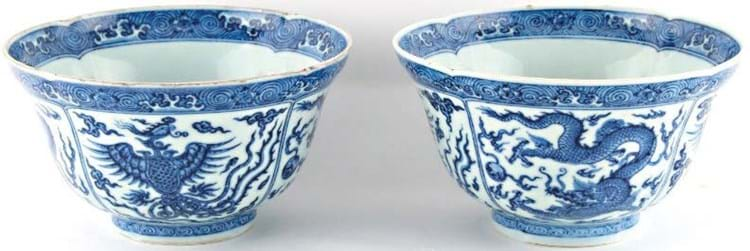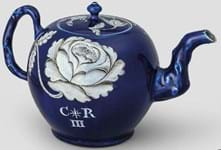
The unsold lot returned to the vendor at a cost of £3450.
Simon Pearce, director at Semley Auctioneers in Shaftesbury, Dorset, had fought to retain possession of a pair of Qing blue and white bowls knocked down to a Chinese internet bidder in November 2020 for £280,000 (£354,000 including fees).
He contended that the bowls had been sold and argued that the vendor’s request to return them six months after no funds were received amounted to them cancelling the sale.
Morland collection
Semley Auctioneers had secured one of the choice regional consignments in the autumn 2020 Asian art series – the Martin Robert Morland (1933-2020) collection of Chinese ceramics on November 7. Morland, who served in the Grenadier Guards before becoming a diplomat, bought mainly Qing blue and white wares in the 1970s-80s.
The 37 lots, sold on behalf of Morland’s children, generated a hammer total of £457,000 with the auctioneer in line to receive both the full 15% vendor’s commission and the 22% buyer’s premium from the sale.
Within the auctioneer’s standard 30-day terms, all lots were paid for with the exception of a near pair of Yongzheng (1723-35) mark and period ‘dragon and phoenix’ bowls that had ‘sold’ at £280,000 – more than 10 times the top estimate.
The vendors were told first in December that, as the buyer had gone ‘quiet’, they should consider a cash offer from another party of £140,000 and later that reassurances had been received from the Chinese bidder that he would be paying.

A detail of the Yongzheng blue and white ‘dragon and phoenix’ bowls.
Instead the Morland siblings, content with the receipts generated by the rest of the collection, and conscious that another six-figure sale would have inher itance tax implications, made the decision to keep the bowls rather than re-offer them in a subsequent sale.
It was this that made the scenario unusual and caused a previously amicable relationship between vendor and agent to break down.
The Morlands stated that they wished to retain the bowls and made verbal requests to have them returned before engaging legal counsel from Fladgate in January 2021.
Anthony Morland told ATG the family wished to have its property returned and explore “the issue of good practice and to what extent an auctioneer should respect the express wishes of sellers in unusual cases like this”.
A letter from Fladgate to Semley dated February 24 stated: “As our client’s agent, you hold the bowls on their behalf as bailee and have no proprietary interest in them whatsoever. The Unfair Contract Terms Act would not entitle you to adopt a position of unrelenting and indefinite paralysis in relation to retention of the bowls until the buyer pays the purchase price.”
In return, they received a letter dated April 21 from Milton Silverman of Streathers Solicitors acting for Semley Auctioneers. It stated that, as the auctioneer still believed the Chinese bidder would pay (Pearce says his buyer had threatened legal action on March 5), the vendors were effectively cancelling a sale.
£107,800 in fees
It was calculated that the penalty for this would be the auctioneer’s fees from vendor and buyer amounting to a total of £107,800 (plus VAT) or £65,450 if the Morlands agreed to accept the third party offer.
In an email last week Pearce told ATG: “I am sure that given the regular assurances of being paid in full, the sums involved, and the threat of legal action if we were to cancel the sale, any other auction house would have acted similarly.”
Streathers had advised it was “very common for Chinese purchasers to take over six months to pay” and emphasised that Semley “unarguably [had] a right to possession under the terms of contract with its consignor”.
Lawyer Hetty Gleave, acting for the Morlands, challenged this interpretation of the auction house terms and conditions with a letter on May 12. “We do not agree with your analysis of the terms and conditions or that they entitle your client to retain our clients’ property for more than a reasonable period of time after the auction.
“What is fair and reasonable must be considered in the context of the payment terms that apply to the buyer, which clearly states that the goods must be paid for in full, and removed, within 30 days of the sale, failing which the auctioneer may cancel the contract. Whether or not the bidder is in China is irrelevant.”
It concluded: “Our clients have little faith that the sale to the Chinese buyer will ever conclude” and asked that the bowls be returned if the auction price was not paid in full within a calendar month (June 12).
After the deadline passed Pearce conceded no funds would be forthcoming and he activated an ‘unsold or withdrawn lot fee’ – a common clause in an auction house’s terms and conditions.
As a charge of 15% plus VAT on the pre-sale mid estimate of £15,000-25,000, this was calculated at £3450: he refused to accept an offer of £2000 and declined to hand over the bowls when Morland’s daughter visited the saleroom.
On this issue of a withdrawn lot fee the vendors were advised it would be difficult to fight the case and reluctantly conceded to the payment to bring the matter to a close. ATG understands that the vendors have been informed that the bowls may now be collected, but as of last week they had not yet done so.
Some salerooms choose to take precautions, such as asking for a deposit in advance of the sale, when offering premium lots, particularly Chinese works of art.
On this occasion no restrictions had been applied.














